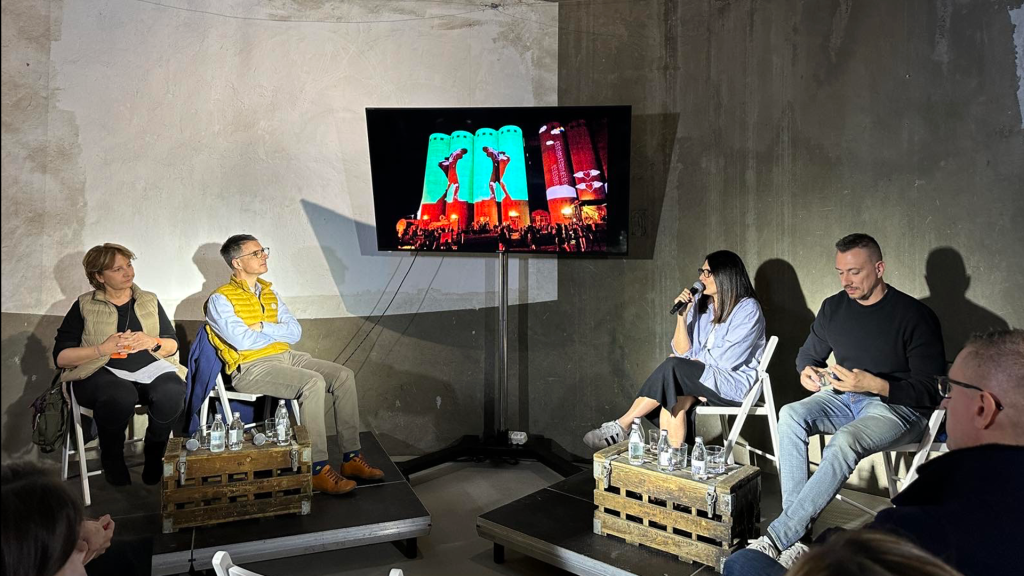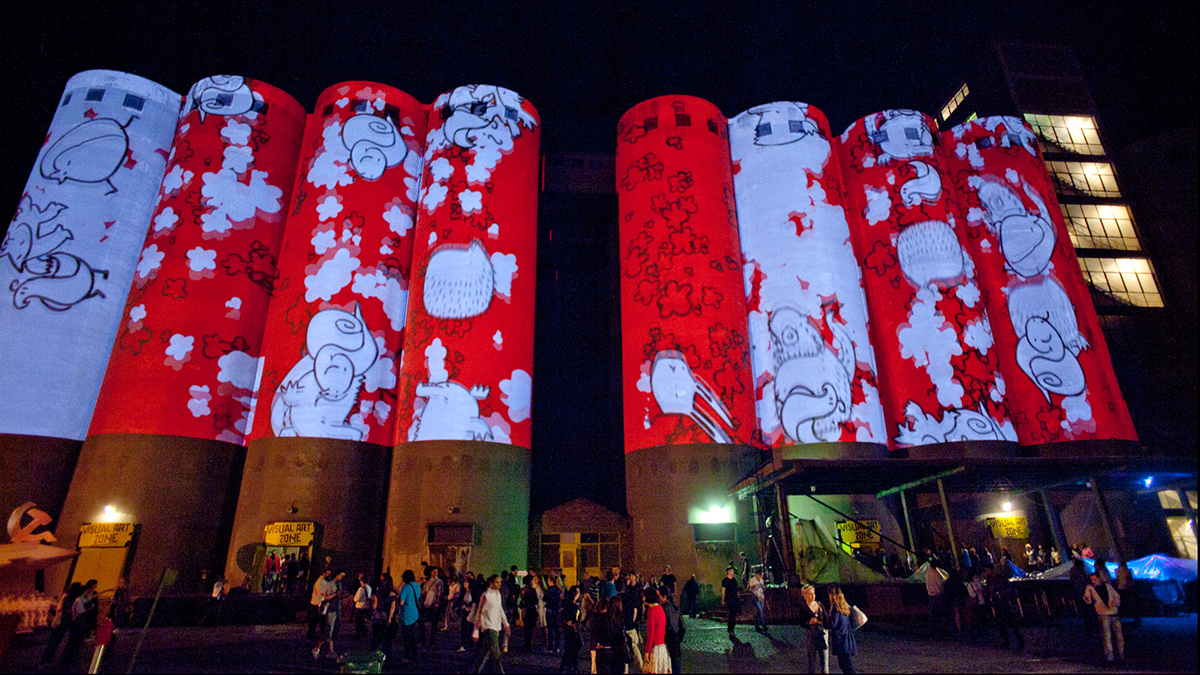euPOLIS Participatory Methodology @Urban Recycling Panel in Belgrade
As part of the fifth exhibition of the Women’s Architectural Society called “Revival”, recently opened in Belgrade’s “Silos”, a series of panels were held that dealt with issues of revitalization and reactivation of neglected and urban cores, circularity in built environments, and awakening the general public about the possibility of influencing what kind of nature and function such spaces, as large organic resources, can acquire in the future.
In the panel “Urban recycling”, Architect Maja Lalić from Mikser shared with the interlocutors and the audience the experience of activation of the “Silos” and industrial facilities of Savamala district, which were not available to the public at that time, through the Mikser Festival and Mikser House cultural platforms. Through these examples of the Mikser experience in creating and maintaining communities in previously abandoned and neglected areas, Maja presented the participatory methodology and one of the core technologies embedded in the euPOLIS project – the creation of the community hub that would serve as a meeting point for the citizens (experts), decision-makers and representatives in different urban design disciplines in situations where the official city tools and capacities are not sufficient to meet all the needs from different interest groups and stakeholders.

Along with Maja Lalić, Darko Polić, architect-urban planner from Novi Sad, and Marko Korošec from “Remorker Architects” took part in the discussion, while the conversation was moderated by Žaklina Gligorijević, urban planner and former director of the Urban Institute.
– How can derelict spaces in Belgrade be revitalized without large investments? This is a common question of architects and urban planners in times of social crisis. The threat to authentic architecture in such transitional times is almost a rule, and then two opposing principles become obvious. One is the exploitation of natural resources, including land, while the other is the desire to preserve historical identities and characters – Gligorijević started the discussion.
As inspiration and examples for conversation, she also presented several examples of the revitalization of Belgrade neighborhoods such as Prince Miloš’ Hammam, Barutana, Staro Sajmište (Old Fairground), and others…
-Belgrade is a good training ground for urban recycling. If anyone remembers what today’s Beton Hall looked like 30 years ago, they know that it was a part of the city where you didn’t go: chicken coops, coffee roasters, and, in other words, an unsightly corner. The revival of this space began when an individual opened a second-hand clothing store there, which slowly grew into a fashion show. The first loudspeakers came outside, the first public events began to be organized here, like the large gathering of urban planners of Barcelona in Belgrade in 2007. This completely changed the purpose and appearance of this space – stated Gligorijević and added that architecture is not just the construction of buildings, it is a catalyst. and should be a catalyst for processes and relationships, the atmosphere in the city.
Maja Lalić followed up by drawing attention to how in some local circles gentrification is still considered a positive phenomenon as a permanent condition while the public forgets what public interest is and what and where is that square, the agora where we as citizens meet and maintain dialogue.
-I am not sure that there is a society that has managed to maintain that kind of dialogue and interaction between citizens and institutions and make them permanent. Revolutionaries have no work after the revolution, but these relationships are so dynamic that it is necessary to constantly adapt, change, and monitor them closely. It is important to bring the citizens of Belgrade to all these places, to familiarize them with a different aesthetic and purpose. We did not have time to build a relationship with the modernist heritage, and there is a serious threat that this heritage will be destroyed before we see its value – Maja Lalić pointed out and added that billions are not always necessary to start such a process, but only a timely and good incentive for creatives to enable the audience perhaps the first direct contact with art.
Darko Polić recalled the revival of „Chinatown” in Novi Sad as part of the European Capital of Culture project.
You do not tear down the Colosseum
During the conversation, Korošec pointed out that citizens do not participate in public debates about public spaces and do not get involved in decision-making processes because no one systematically informs them.
–The issue of the (tearing down of the Belgrade) Fair, for example, is very complicated because, from the economic aspect, it is a very difficult, large, and expensive job. But! But the Fair is a Colosseum of brutalist architecture, and you just don’t tear down the Colosseums!!! Maybe some new generations of architects and designers will curse their grandparents for allowing such a monument to be erased from the face of Belgrade – warned Korošec.
-Of course, something already existed here, quietly smoldering, but it never took shape before that. But just to be clear, EPK is a political project. However, this is where a real creative district was born. I was completely mesmerized by the diversity and unexpected symbioses: A studio for contemporary music, which is engaged in researching the sound of electric motors, teamed up with a refrigerator repair service… Of course, this project was helped significantly by the fact that Novi Sad was declared the Youth Capital of Europe a few years earlier and it was extremely easy to combine youth entrepreneurship, creativity, etc. This is how those famous cultural stations such as Svilara were created – reminded Polić.
As one of the important items for the revitalization of old neighborhoods and buildings, Marko Korošec pointed out the difference between buildings protected by the measures of the Institute for the Protection of Cultural Monuments and those that are not, since this greatly changes the procedures. But the mitigating circumstance is that the foundations of the buildings are mostly optimal and the architect, even if he were to build from scratch, would very likely set things up the same way.
-In the light of a globally important topic, the Green Agenda and the mission to reduce CO2, the renovation of buildings is preferable to the construction of new ones, and this is even more logical for us here due to 20 years of economic stagnation. Of course, the renovation of buildings implies far less use of raw materials and concrete, and thus less carbon dioxide emissions. On the other hand, regardless of the predicted duration of reinforced concrete of some 100 years, you have to reconstruct the building for about thirty years. One reason is technological and the building no longer has that kind of capacity for modern business, and the other is that the way of doing business has changed and the building no longer supports that function – said Korošec.
At the end of the discussion, Maja Lalić pointed out that even the European practice in better environments has not completely mastered the broad participation of citizens in the decision-making processes about the purpose and appearance of public spaces.

-The example of the Savamala refugee center alone can explain just how endless these processes are, how citizens must constantly emancipate themselves and practice that participation, and decision-makers must constantly question themselves. With the arrival of migrants, we had a lot of resistance from the surrounding residents, but through numerous conversations, joint activities, workshops, and mutual support, we reached the point where the entire neighborhood was dedicated to one, great and humane goal. There is now an awareness that citizens are the greatest experts for their needs and any planning of public spaces would have to include this expertise, their experience, in its design. Consensus is now fluid because there is a constant fluctuation of needs and society is a constant classroom. So, in addition to revitalizing a neglected neighborhood of Savamala, this was a continuous training ground for broad participation for citizens and the incorporation of these principles into official decision-making processes on matters of public importance. Today, these ideas form the basis of several European projects that deal with the impact of blue-green public areas on people’s health and well-being and the involvement of citizen experts in the design of such solutions. Cities like Aarhus and Copenhagen in Denmark, Łódź in Poland, Athens and Piraeus in Greece, which are the pilot cities of the HEART and euPOLIS projects, directly apply these methodologies in the planning of blue-green interventions in public areas – Maja Lalić concluded.

